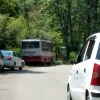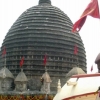We had planned a night halt in Agra while coming back from Jaipur by road. We reached Agra by around 1.00 pm and post lunch decided to visit Sikandara complex.
While searching through photo archives of my father, I realised that my first visit to Sikandara complex was when I was around a year and a half; I don’t remember anything of that trip. The earliest trip in my memory of Sikandara complex is that as a child of 6 or 7 year old. I still have those black and white photographs from my dad’s collection, who is an internationally trained photographer, when the place was not managed the way it’s being managed now. The only memories I had of the complex was that there was a big gate to go inside and then there used to be a small pond like empty structure where the Langurs were playing. Beyond that I had no memories of Sikandara.
The Sikandara complex, which one can now visit, comprises of three main structures– the main tomb complex, the Kaanch Mahal and the Lodi structure. The Sikandara complex has changed, though the gate and the pond like structure were still there in the main tomb complex. Some parts have been restored and restoration work was going on some areas. The only thing which was missing was details about the complex. I hope the ASI takes care of it soon. Lack of official details forces people to rely on guides, and this necessity, aides a lot many self styled untrained guides. Sikandara also had a hoard full of such guides including many middle aged ladies who probably are residents of locations nearby. You tell a lie a thousand times and it becomes the truth. This is what was happening there, for a small amount they were shelling out historically inaccurate stories probably heard from some other similar members. (I came across a couple of YouTube videos shot by tourists where the same lie is being told by these self styled untrained guides).
Sikandara is located on the outskirts of main Agra city. If one was travelling from Delhi to Agra via NH 19/NH 44 (via Mathura), Sikandara complex would be the first monument falling on the left. If one is coming from the main city (MG Road), one needs to take a left from Hari Parwat crossing towards Raja Ki Mandi and continue on the road straight till Guru Ka Taal Flyover, take the flyover and one would be connected to NH19/NH44 right in front of the Guru Ka Taal Gurdwara complex. Drive straight, Sikandara would be on the right.
The place Sikandara got its name after its founder Sikandar Lodi. The entire area is dotted with many Lodi era structures (so much so that the tomb of Mariam-uz-Zamani is a restructured/converted Lodi time Baradari – pleasure pavilion).
This place is being maintained by ASI and is a ticketed tourist destination. Indian Tourists currently pay Rs. 20 per person and children below 15 years are free. The complex is open from sunrise till sunset on all days. The complex has ample parking space and right at the entry you have a toilet complex (cleanliness at its lowest, though this was one of those paid complexes).
From the parking space when you move inside, on your right hand side is the first monument in this complex – a Lodi era tomb, no information is available regarding whose tomb it is. Just a few steps ahead, the Kaanch Mahal (literal meaning – Glass Palace) is located. Please don’t go by the literal meaning of this building. This building was never made out of glass or kaanch as many would love to believe.
Kaanch Mahal has got its name owing to the exterior embellishments with mosaic of blue, orange and yellow glazed tiles. It’s a two storied red sandstone structure having a central square hall and four square rooms on the four corners of the building. (When we were there, these side rooms were filled with material which was being used for restoration – lime etc.). There are Jharokhas and gaukhs (balconies) in the rooms (both on the ground floor and the top floor) making the floors airy and open. One can see beautiful carvings on the red sandstone – patterns of lotus flower in bloom, floral creepers, wine vases, arabesque and geometrical designs.
The Kaanch Mahal was earlier under the Church Missionary Society and was in quite a dilapidated condition. It was then acquired by ASI, and ASI is now restoring and conserving it (whatever is left i.e. only northern facade). The original Kaanch Mahal was surrounded by a garden with causeways, water courses and tanks. ASI is now maintaining the greenery around the Kaanch Mahal. The monument is assigned to the period from 1605-1619 and had dual usage – as a harem quarter or resort for ladies and as the hunting lodge (royal shikargah) by Jahangir.
From Kaanch Mahal one needs to walk on to the left to reach the Akbar’s tomb complex.
The Mughals religiously followed the Tartary custom of building one’s tomb in one’s lifetime, Akbar was no exception. He had started building his own mausoleum but he died before its completion and the tomb was completed by his son Jahangir (the tomb was completed in 1613).
Akbar had founded a new religion Din-i-Ilahi which incorporated all good points from various religions which were being followed in his kingdom and also around the world. The impact of the same can be seen in the tomb complex.
The tomb complex is enclosed in a wall with four large sandstone gates facing different directions, which lead to the mausoleum. Only the Southern gate is used (rest were designed for ornamental purpose (dummy gates) – a feature that was common in architecture of that time). The northern gateway is in ruins now, it was struck by lightning some years ago. The eastern and western gates are identical. The large southern gateway (similar to the Buland Darwaza and other entrance gates at Humayun’s Tomb, Taj Mahal etc.) has beautiful decorations, white marble mosaic patterns set in sandstone. The tickets are checked at this point. You need climb 3-4 steps, as this entry gate is on a raised platform. Just below the platform, ASI has installed two information stone slabs. The stone slabs desperately need restoration.
There are four white marble minarets on the four corners of the south gates, they remind you of the minarets of Taj Mahal (a feature which was probably taken from here for Taj Mahal).
In the entire complex one can see hybrid of different style architecture – Hindu, Islamic (in particular Arabic and Persian), Christian, Jain and Buddhist – a patent style of Akbar as a result of his religious inclinations.
The tomb is shaped as a truncated pyramid and has five storeys. A broad paved pathway which is surrounded by beautiful gardens (another Mughal feature) leads one to the tomb. Jahangir had made some changes in the original designs including inlaying semi precious stones.
The entire tomb except the top story is built of sandstone. The top story is built of marble. One can now only see the ground floor. Rest all the floors are closed for tourists. I could find a photograph from my dad’s archives where we are actually on the 2nd or 3rd floor of the complex (probably it used to be open for general public then).
The ground floor is square shaped with arched verandahs which divide the whole area in different bays. To see Akbar’s tomb, one needs to enter the central courtyard after taking off the shoes. The original cenotaph (Akbar’s real tomb) is a level below the ground level. The tombstone which one sees after entering is not the burial place of Akbar, it’s the replica made in marble beautifully carved with Arabic patterns and designs. This room/area is has beautiful jaalis and coloured motifs on the walls and the roof (the colour gold is quite prominent making the place look regal). In comparison to this bright royal looking chamber, the vestibule leading to the main burial chamber where the original cenotaph is located and the chamber itself are quite bare – only paved stones, no carvings no motifs, nothing. It’s as if in death one has left everything which is mortal behind, it’s a dimly lit chamber. We saw an Islamic care taker for this place, who was dishing out stories about annual Urs being held at the tomb (don’t know how much truth is there in this, as I could not find any details of the same). He also informed that this tomb can fulfil one’s wishes requesting for donations for the upkeep (upkeep of the property which is under ASI?!). To create an atmosphere he also showed us how the chamber echoes the sound of Akbar (not Akbar the king but Allah o Akbar). I don’t know the truth in wish fulfilling tomb as this is the tomb of a king and not of a saint or sufi. As per another story which I have read, during the reign of Aurangzeb, under the leadership of Raja Ram Jat, the rebellious Jats had ransacked the intricate tomb, plundered and looted all semi precious and precious items of the tomb of Akbar. To avenge his father Gokula’s cruel death, he not only looted the tomb, he dragged Akbar’s bones to burn them in retaliation. (Ref. Hansen, Waldemar (1986-09-01). The Peacock Throne: The Drama of Mogul India. Motilal Banarsidass Publ. ISBN 978-8-12080-225-4.). Raja Ram Jat was later sentenced to death by Aurangzeb. (The care taker didn’t allow us to take the photographs of the inner chamber)
After coming out of the central chamber, one can visit the other rooms where there are four cenotaphs. While showing these graves, the self styled guides attribute one of the graves to be that of Ruqqiya Begum (Akbar’s first wife) and the other graves to be that of Akbar’s kids (twins of the Hindu Rani and one more). This is historical inaccuracy at its height. These are the tombs of Akbar’s daughters – Shakrul Nisha Begum and Aram Bano, tomb of Aurangzeb’s daughter Zebu-n-nisa and tomb of Shah Alam’s son Sulaiman Shikoh. (Akbar’s first wife is buried in Kabul (as per her wishes) in the garden of Babur and not in Sikandara, the other stuff also is incorrect).
The self styled guides dish out stories about the architectural marvels of the arched verandahs – echo points, telephone system of that time and soon. These stories have been created by whatever they could pick up from the official guides, their own beliefs etc. All said and done they are beautiful story tellers – they dish out lies with so much conviction that one may love to believe that this is the Truth.
The backside of the tomb (i.e. towards the north gate) is a peaceful haven. The peace is disturbed only by parrots, who have been living there since eternity and the Love Birds-couples who find the arches a perfect spot to indulge in activities to satisfy their carnal desires. These Love Birds are not bothered with the tourist – in fact they have become quite tourist friendly, there was a guard also present who was not at all bothered by their activities.
The complex gardens are a peaceful sanctuary for various animals, we could spot some deer grazing, peacocks, peahens, water birds like cranes etc. and yes the residents from eternity – the Langurs.
One doesn’t feel like disturbing the peace at Sikandara and I sincerely hope that the official care takers take a note of the activities at Sikandara and ensure that the dignity of the place is not disturbed by anyone including rowdy tourists.



Comments